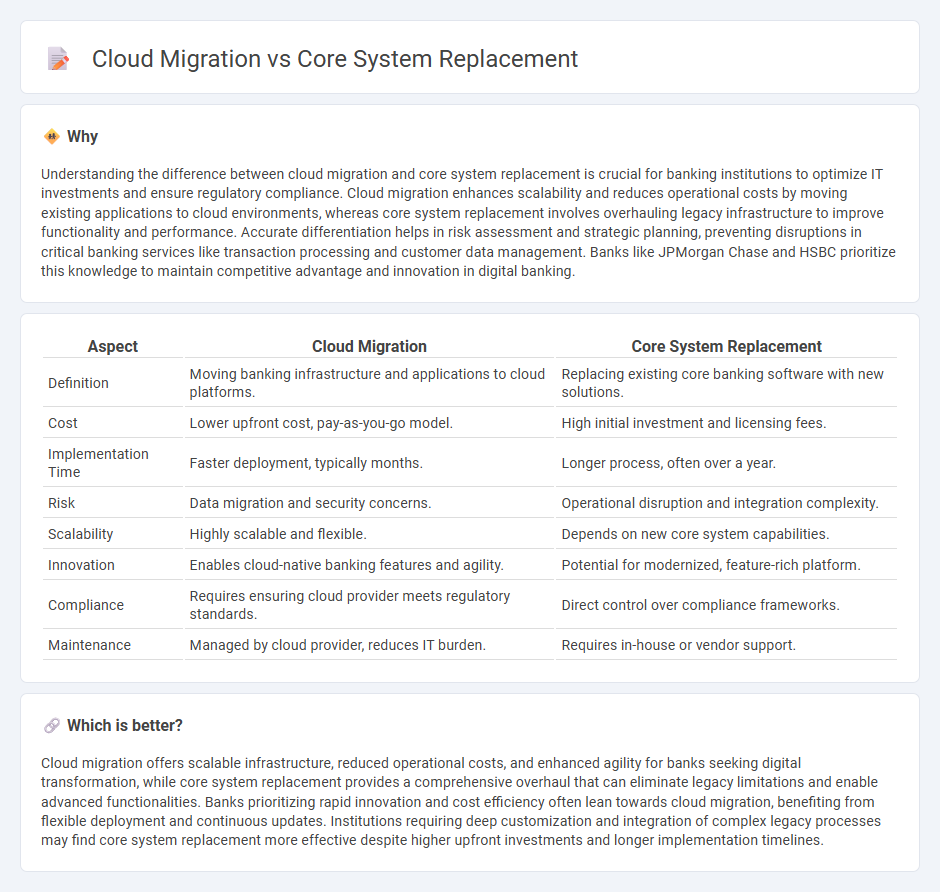
Cloud migration offers banks scalable, cost-effective solutions by leveraging virtualized infrastructure and advanced security protocols, enabling seamless integration with digital services. Core system replacement involves overhauling legacy banking platforms to enhance performance, compliance, and customer experience, though it requires significant investment and risk management. Discover the key factors to consider when choosing between cloud migration and core system replacement in banking.
Why it is important
Understanding the difference between cloud migration and core system replacement is crucial for banking institutions to optimize IT investments and ensure regulatory compliance. Cloud migration enhances scalability and reduces operational costs by moving existing applications to cloud environments, whereas core system replacement involves overhauling legacy infrastructure to improve functionality and performance. Accurate differentiation helps in risk assessment and strategic planning, preventing disruptions in critical banking services like transaction processing and customer data management. Banks like JPMorgan Chase and HSBC prioritize this knowledge to maintain competitive advantage and innovation in digital banking.
Comparison Table
| Aspect | Cloud Migration | Core System Replacement |
|---|---|---|
| Definition | Moving banking infrastructure and applications to cloud platforms. | Replacing existing core banking software with new solutions. |
| Cost | Lower upfront cost, pay-as-you-go model. | High initial investment and licensing fees. |
| Implementation Time | Faster deployment, typically months. | Longer process, often over a year. |
| Risk | Data migration and security concerns. | Operational disruption and integration complexity. |
| Scalability | Highly scalable and flexible. | Depends on new core system capabilities. |
| Innovation | Enables cloud-native banking features and agility. | Potential for modernized, feature-rich platform. |
| Compliance | Requires ensuring cloud provider meets regulatory standards. | Direct control over compliance frameworks. |
| Maintenance | Managed by cloud provider, reduces IT burden. | Requires in-house or vendor support. |
Which is better?
Cloud migration offers scalable infrastructure, reduced operational costs, and enhanced agility for banks seeking digital transformation, while core system replacement provides a comprehensive overhaul that can eliminate legacy limitations and enable advanced functionalities. Banks prioritizing rapid innovation and cost efficiency often lean towards cloud migration, benefiting from flexible deployment and continuous updates. Institutions requiring deep customization and integration of complex legacy processes may find core system replacement more effective despite higher upfront investments and longer implementation timelines.
Connection
Cloud migration and core system replacement in banking are interconnected processes that enable financial institutions to enhance scalability, reduce operational costs, and improve service agility. Migrating core banking systems to the cloud facilitates real-time data processing, increased security, and seamless integration with modern fintech solutions. This transformation supports regulatory compliance, improves customer experience, and drives innovation in digital banking services.
Key Terms
Core System Replacement:
Core system replacement involves updating or completely overhauling existing legacy systems to improve efficiency, security, and scalability within an organization's IT infrastructure. This process reduces dependency on outdated technology, enhances real-time data processing, and supports tailored functionalities that align with specific business requirements. Discover the benefits and challenges of core system replacement to make informed decisions about your enterprise technology strategy.
Legacy Systems
Core system replacement involves upgrading outdated legacy systems with modern, integrated platforms that enhance performance and support new business models, whereas cloud migration shifts legacy applications and data to scalable cloud environments to improve accessibility and reduce infrastructure costs. Both approaches address limitations of legacy systems but differ in implementation complexity, cost, and flexibility. Explore detailed strategies and case studies on managing legacy systems transformation for better business outcomes.
Data Migration
Data migration during core system replacement involves transferring large volumes of structured data from legacy platforms to new, often on-premise systems, requiring thorough validation and integrity checks to minimize downtime and data loss. Cloud migration data processes emphasize scalable, automated tools to securely move and synchronize data across distributed cloud environments, ensuring compliance with data sovereignty and security standards. Explore further to understand best practices and tools for seamless data migration in both scenarios.
Source and External Links
Core Systems Replacement in Government | Info-Tech Research - Emphasizes the importance of a holistic, strategic approach--including early stakeholder involvement, robust governance, and alignment with organizational goals--to overcome delays, cost overruns, and resistance, ultimately leading to more successful and sustained modernization outcomes in government.
Replacing Your Bank's Core System? Enterprise Architecture Is Key - Highlights that successful core system replacement in banking requires embedding the new platform in a best-practice reference architecture framework, ensuring alignment with regulatory requirements and enabling the delivery of strategic business objectives and modern customer experiences.
Core Banking Systems and Options for Modernization - Outlines three main modernization strategies--full replacement, component-based replacement, and augmentation--and illustrates how a phased, component-based approach can minimize risk and disruption while allowing banks to modernize incrementally.
 dowidth.com
dowidth.com